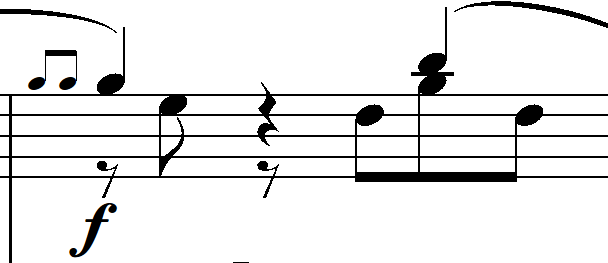After receiving the feedback from Mr. Standford, I tried to alter a couple of points in the piece.
The first issue appeared in section B, first time (bars 25 and following). My tutor commented that there were bigger contrapuntal possibilities not being used. It really sounded too empty, as compared to the first section. I fully understand that the emptiness of these bars may be uncomfortable to the listener – which was partially the purpose of it. So I wondered whether the same programmatic ideas could be achieved in a different way. However simplistic, my proposal is as follows:
This keeps within the motifs of the piece. Also, from the programmatic side, the flute is approaching – which fits the idea better than before. Maybe the ppp in bar 26 is too low: I would need to listen to real players to make sure.
Regarding the rhythm of this section, with almost the same structure for both instruments in bars 30-36, I wasn’t quite sure how to solve that when I wrote the original piece. The encrypted word phobos is in the rhythm for the bassoon (bars 25-30), copied by the flute (bars 31-36). While writing, I wondered whether to change totally the rhythm of the bassoon, to keep it, or to change it partially (the last one being my final decision in the piece I sent). I was aware of sacrificing the musical interest for the hidden message. Setting the bassoon to p and the flute for mf would take too much importance from the bassoon in its own section – so the final solution was adding more “background” (the piano). For these reasons, I’d rather keep those bars unchanged.
As for the repetition of section B (bars 52-63), I considered what I could add. Because I was playing with two modes, I thought a third tuned voice could be too disruptive, and the bass drum could give too strong a sense of rhythm which I didn’t want here – players may play a bit rubato here and there. I’ve left this second part unchanged for the time being, but I’ll probably come back to it at some point.
There was another issue towards the end. Mr. Standford’s correction for bar 94 was to change the first note, an Ab, into the G# of the key signature:
For reasons of encrypting, I wanted the G# not to be a G# but an Ab instead. On the other hand, I must agree that an Ab is a nonsense here. How could I emphasize I wanted a different note to be read by those “solving” the encryption? In the past, I’ve pointed out a “not-what-you-see” by writing it three times in poems or songs. This means a triple G# here. I tried an acciaccatura. It sounded better with the second note of the acciaccatura being transposed one octave up, but that may be too complicated to play. A repetition of the same G# didn’t sound that well on the computer, but it is what I finally wrote.
So I guess with this I’ve come to the end of my first year at OCA. I’ve learnt a lot, I’ve enjoyed a lot, and I’m very much looking forward to continuing! Thanks to Patric Standford for all his help and support, and also to all those friends that have kept reading and listening!



